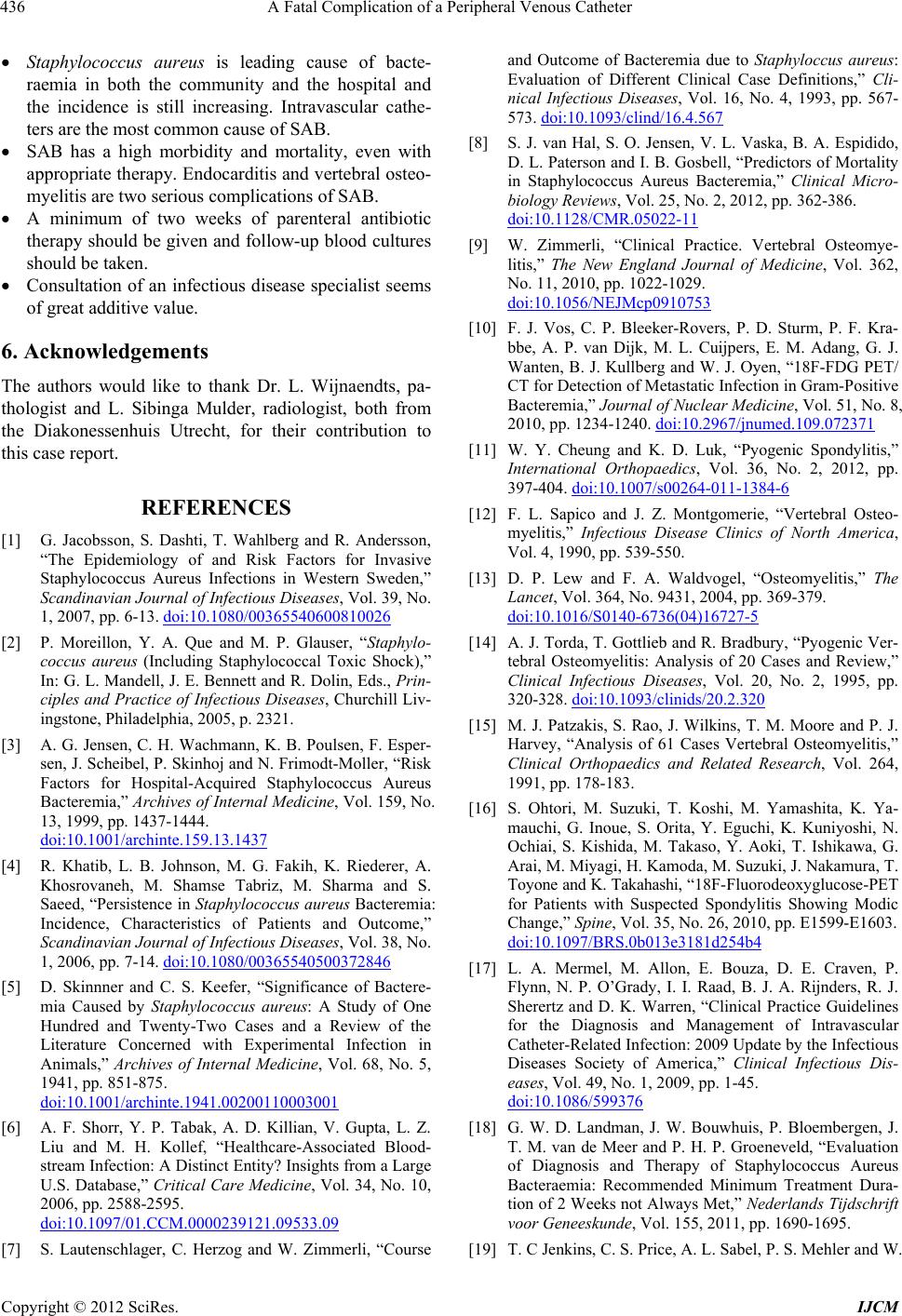
A Fatal Complication of a Peripheral Venous Catheter
436
Staphylococcus aureus is leading cause of bacte-
raemia in both the community and the hospital and
the incidence is still increasing. Intravascular cathe-
ters are the most common cause of SAB.
SAB has a high morbidity and mortality, even with
appropriate therapy. Endocarditis and vertebral osteo-
myelitis are two serious complication s of SAB.
A minimum of two weeks of parenteral antibiotic
therapy should be given and follow-up blood cultures
should be ta ken.
Consultation of an infectious disease specialist seems
of great additive value.
6. Acknowledgements
The authors would like to thank Dr. L. Wijnaendts, pa-
thologist and L. Sibinga Mulder, radiologist, both from
the Diakonessenhuis Utrecht, for their contribution to
this case report.
REFERENCES
[1] G. Jacobsson, S. Dashti, T. Wahlberg and R. Andersson,
“The Epidemiology of and Risk Factors for Invasive
Staphylococcus Aureus Infections in Western Sweden,”
Scandinavian Journal of Infectious Diseases, Vol. 39, No.
1, 2007, pp. 6-13. doi:10.1080/00365540600810026
[2] P. Moreillon, Y. A. Que and M. P. Glauser, “Staphylo-
coccus aureus (Including Staphylococcal Toxic Shock),”
In: G. L. Mandell, J. E. Bennett and R. Dolin, Eds., Prin-
ciples and Practice of Infectious Diseases, Churchill Liv-
ingstone, Philadelphia, 2005, p. 2321.
[3] A. G. Jensen, C. H. Wachmann, K. B. Poulsen, F. Esper-
sen, J. Scheibel, P. Skinhoj and N. Frimodt-Moller, “Risk
Factors for Hospital-Acquired Staphylococcus Aureus
Bacteremia,” Archives of Internal Medicine, Vol. 159, No.
13, 1999, pp. 1437-1444.
doi:10.1001/archinte.159.13.1437
[4] R. Khatib, L. B. Johnson, M. G. Fakih, K. Riederer, A.
Khosrovaneh, M. Shamse Tabriz, M. Sharma and S.
Saeed, “Persistence in Staphylococcus aureus Bacteremia:
Incidence, Characteristics of Patients and Outcome,”
Scandinavian Journal of Infectious Diseases, Vol. 38, No.
1, 2006, pp. 7-14. doi:10.1080/00365540500372846
[5] D. Skinnner and C. S. Keefer, “Significance of Bactere-
mia Caused by Staphylococcus aureus: A Study of One
Hundred and Twenty-Two Cases and a Review of the
Literature Concerned with Experimental Infection in
Animals,” Archives of Internal Medicine, Vol. 68, No. 5,
1941, pp. 851-875.
doi:10.1001/archinte.1941.00200110003001
[6] A. F. Shorr, Y. P. Tabak, A. D. Killian, V. Gupta, L. Z.
Liu and M. H. Kollef, “Healthcare-Associated Blood-
stream Infection: A Distinct Entity? Insights from a Large
U.S. Database,” Critical Care Medicine, Vol. 34, No. 10,
2006, pp. 2588-2595.
doi:10.1097/01.CCM.0000239121.09533.09
[7] S. Lautenschlager, C. Herzog and W. Zimmerli, “Course
and Outcome of Bacteremia due to Staphyloccus aureus:
Evaluation of Different Clinical Case Definitions,” Cli-
nical Infectious Diseases, Vol. 16, No. 4, 1993, pp. 567-
573. doi:10.1093/clind/16.4.567
[8] S. J. van Hal, S. O. Jensen, V. L. Vaska, B. A. Espidido,
D. L. Paterson and I. B. Gosbell, “Predictors of Mortality
in Staphylococcus Aureus Bacteremia,” Clinical Micro-
biology Reviews, Vol. 25, No. 2, 2012, pp. 362-386.
doi:10.1128/CMR.05022-11
[9] W. Zimmerli, “Clinical Practice. Vertebral Osteomye-
litis,” The New England Journal of Medicine, Vol. 362,
No. 11, 2010, pp. 1022-1029.
doi:10.1056/NEJMcp0910753
[10] F. J. Vos, C. P. Bleeker-Rovers, P. D. Sturm, P. F. Kra-
bbe, A. P. van Dijk, M. L. Cuijpers, E. M. Adang, G. J.
Wanten, B. J. Kullberg and W. J. Oyen, “18F-FDG PET/
CT for Detection of Metastatic Infection in Gram-Positive
Bacteremia,” Journal of Nuclear Medicine, Vol. 51, No. 8,
2010, pp. 1234-1240. doi:10.2967/jnumed.109.072371
[11] W. Y. Cheung and K. D. Luk, “Pyogenic Spondylitis,”
International Orthopaedics, Vol. 36, No. 2, 2012, pp.
397-404. doi:10.1007/s00264-011-1384-6
[12] F. L. Sapico and J. Z. Montgomerie, “Vertebral Osteo-
myelitis,” Infectious Disease Clinics of North America,
Vol. 4, 1990, pp. 539-550.
[13] D. P. Lew and F. A. Waldvogel, “Osteomyelitis,” The
Lancet, Vol. 364, No. 9431, 2004, pp. 369-379.
doi:10.1016/S0140-6736(04)16727-5
[14] A. J. Torda, T. Gottlieb and R. Bradbury, “Pyogenic Ver-
tebral Osteomyelitis: Analysis of 20 Cases and Review,”
Clinical Infectious Diseases, Vol. 20, No. 2, 1995, pp.
320-328. doi:10.1093/clinids/20.2.320
[15] M. J. Patzakis, S. Rao, J. Wilkins, T. M. Moore and P. J.
Harvey, “Analysis of 61 Cases Vertebral Osteomyelitis,”
Clinical Orthopaedics and Related Research, Vol. 264,
1991, pp. 178-183.
[16] S. Ohtori, M. Suzuki, T. Koshi, M. Yamashita, K. Ya-
mauchi, G. Inoue, S. Orita, Y. Eguchi, K. Kuniyoshi, N.
Ochiai, S. Kishida, M. Takaso, Y. Aoki, T. Ishikawa, G.
Arai, M. Miyagi, H. Kamoda, M. Suzuki, J. Nakamura, T.
Toyone and K. Takahashi, “ 18 F- Fl uor od eox y gluc os e- PET
for Patients with Suspected Spondylitis Showing Modic
Change,” Spine, Vol. 35, No. 26, 2010, pp. E1599-E1603.
doi:10.1097/BRS.0b013e3181d254b4
[17] L. A. Mermel, M. Allon, E. Bouza, D. E. Craven, P.
Flynn, N. P. O’Grady, I. I. Raad, B. J. A. Rijnders, R. J.
Sherertz and D. K. Warren, “Clinical Practice Guidelines
for the Diagnosis and Management of Intravascular
Catheter-Related Infection: 2009 Update by the Infectious
Diseases Society of America,” Clinical Infectious Dis-
eases, Vol. 49, No. 1, 2009, pp. 1-45.
doi:10.1086/599376
[18] G. W. D. Landman, J. W. Bouwhuis, P. Bloembergen, J.
T. M. van de Meer and P. H. P. Groeneveld, “Evaluation
of Diagnosis and Therapy of Staphylococcus Aureus
Bacteraemia: Recommended Minimum Treatment Dura-
tion of 2 Weeks not Always Met,” Nederlands Tijdschrift
voor Geneeskunde, Vol. 155, 2011, pp. 1690-1695.
[19] T. C Jenkins, C. S. Price, A. L. Sabe l, P. S. Me hler a nd W.
Copyright © 2012 SciRes. IJCM